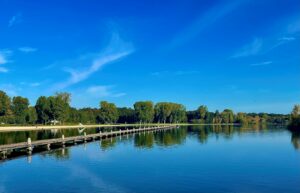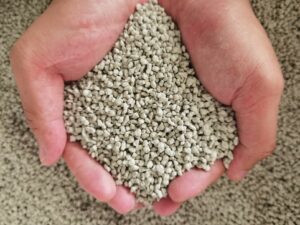OnSite has partnered with PET to help manage phosphate pollution in UK inland waterways.

The problem
Eutrophication or excessive richness of nutrients (including phosphates) in a lake or other body of water, frequently due to run-off from the land, causes a dense growth of plant life and algae preventing the light penetration and oxygen absorption necessary for underwater life.
How can we help you?
We can help return your inland waterways to health by enhancing water quality:
- using trusted and proven water remediation technologies
- applying seamless, end to end water management solutions
- implementing a safe and environmentally friendly technology to remediate polluted waters
What is Phoslock®?
Applied to static a flowing bodies of water, Phoslock is a proprietary water treatment technology that permanently binds excess phosphorous in the water column and sediments and settles in an environmentally benign state.
- Consists of lanthanum (5%) -modified bentonite (95%)
- Binds with phosphate to form a non-bio available, non-toxic, inert mineral rhabdophane
- Up to 90% of available Phosphate (not organic bound) in the water column is bound in the first hour
- Has been successfully applied to hundreds of water bodies worldwide
- Has reduced in-water phosphorus concentrations in more than 20 countries
- Does not pose any risk to freshwater biota or have any human health related risks.

Phoslock granules
How Phoslock can help your waterways
- Water Quality Enhancement: Phoslock can help to filter and reduce Phosphate pollutants in the water, improving overall water quality and supporting aquatic life.
- Ecology: Improving and supporting the pulse of all freshwater environments through nutrient pollution reduction.
- Habitat Improvement: Phoslock can create suitable conditions for various aquatic plants and animals, enhancing biodiversity and promoting healthy ecosystems.
- Nutrient Management: It can assist in managing the excess nutrient phosphorus, preventing algal blooms that can harm aquatic environments.
- Sediment Control: By controlling sediment transport, Phoslock can help maintain clearer water and reduce issues related to sedimentation and nutrient loading/transfer downstream.
- Aesthetic Value: Improving the physical appearance of waterways and lakes through the use of Phoslock can enhance recreational opportunities and promote community engagement.
- Reduction of Invasive Species: By promoting healthy native plant growth, Phoslock can inhibit the spread of invasive species that disrupt local ecosystems.
- Microbial Activity Support: Phoslock can enhance microbial activity that breaks down harmful substances in water, improving water quality and promoting healthy biological communities.
- Reduced Thermal Pollution: By fostering vegetation growth, it can help shade the water, reducing temperature fluctuations and preventing thermal pollution, which affects fish and other aquatic life.
- Enhanced Recreational Spaces: Improved water quality and aesthetics can lead to more recreational opportunities, such as fishing, boating, and other water sports, benefiting local economies and community well-being.
- Community Education and Engagement: The use of Phoslock can become a focal point for environmental education, engaging communities in volunteer efforts to maintain and monitor the health of local waterways and lakes.
- Carbon Sequestration: Aquatic plants supported by Phoslock can contribute to carbon sequestration, thus playing a role in climate change mitigation.
- Water Quality: Ensuring your waterways and lakes remain open due to good water quality.
